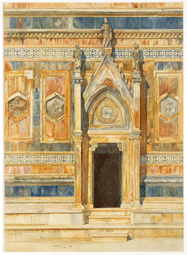Detail of the Campanile of the Cathedral, Florence (Giotto's Tower; the Base and Entrance)
Henry Roderick Newman (c.1843-1917). Watercolour and bodycolour on paper, 1878.
WorkThis watercolour is one of several that Ruskin bought from Henry Newman. Other subjects included the South Door of the Duomo, and the West Front of Lucca Cathedral. Of Newman's drawings of Florence, Ruskin wrote that they were 'Quite the most valuable records yet existing of the old city and her duomo' (Works, 30, p. 73).
ArtistHenry Newman was an American painter. The son of a New York doctor, he originally planned to pursue a career in medicine. Art became the centre of his life when he first read Ruskin's Modern Painters (1843-60).Newman moved to Europe in 1869, and chose Florence for his home. He came to Ruskin's attention when one of his drawings was shown to him: it depicted the piazza and facade of Santa Maria Novella. Ruskin immediately wrote to the artist, indicating the delight his work had caused, and praising 'the sense of tenderness and depth of colour so united', and the signs of 'fidelity and affection joined with a power of design' (Works, 30, p. lxxiii). This was the first of many letters exchanged by the two men. Collection of the Guild of St George, Museums Sheffield
Ruskin on the Campanile of Giotto at FlorenceIn The Seven Lamps of Architecture (1849), Ruskin provides a list of 'noble characters' that satisfy the 'conditions of Power and Beauty', which are 'the grounds of the deepest impressions with which architecture could affect the human mind' (Works, 8, p. 187). Although these characteristics might be found 'more or less in different buildings', they existed 'all together, and in their highest possible relative degrees [...] only in one building in the world, the Campanile of Giotto at Florence.' (Works , 8, p. 188).Recollecting the disappointment of his first visit to Florence, Ruskin suggests that 'In its first appeal to the stranger's eye there is something unpleasing; a mingling, as it seems to him, of over severity with over minuteness.' (Works , 8, p. 188). To this problem he proposes the solution of patience: 'But let him give it time, as he should to all other consummate art'. |



















